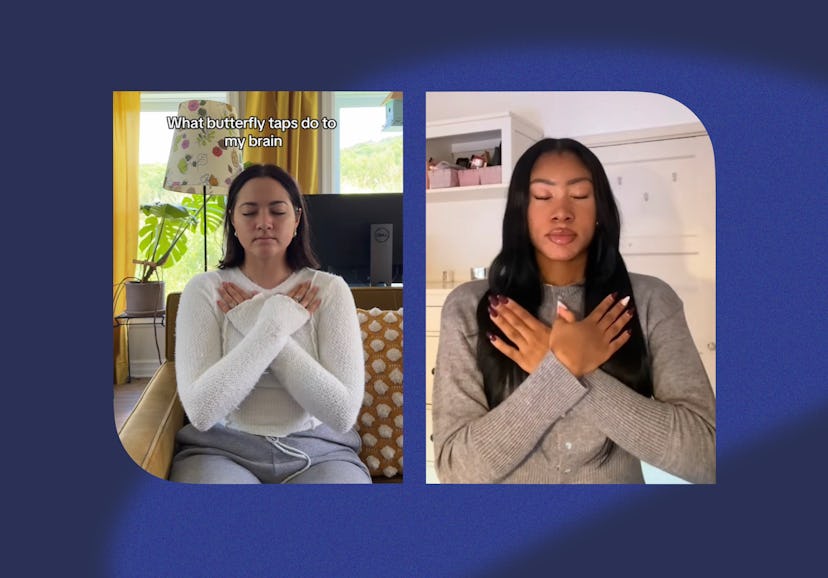Wellness
Need A Quick Fix For Stress? Try “Butterfly Tapping”
Try it before a big interview or a first date.

The next time you’re stressed, sweating, or overwhelmed, cross your arms, give yourself a little hug, and start tapping on your shoulders.
It sounds a little too good to be true, but this simple move — called the “butterfly tapping” technique — works like magic to calm you down. On TikTok, creator @radiatewithangie showed herself taking a deep breath while butterfly tapping as loud, chattering background noise slowly faded to quiet in the clip. The caption read, “What butterfly tapping does to my brain,” showing how it helps her feel centered and at peace.
Angie pulls out the easy-to-do move whenever she’s anxious or dysregulated. In her comments section, one person wrote, “Me too! This is the only thing that truly brings me comfort in the hardest times.” Someone else tried it and said, “Wow, it worked!”
In another video, creator @psychwithann explained that butterfly tapping is a self-soothing technique that triggers the parasympathetic nervous system through gentle taps on your body, and it really does calm you down. It’s a helpful way to release anger, anxiety, overwhelm, she said, as well as any other negative emotion that needs to go. Here’s what to know.
The Benefits Of Butterfly Tapping
According to Lisa Chen, LMFT, a licensed psychotherapist and founder of Lisa Chen & Associates Therapy, butterfly tapping is a grounding technique where you cross your arms over your chest — like you’re hugging yourself — and then you alternate tapping your hands.
It works by helping your body and mind communicate — something that may be a challenge when you’re in the middle of an anxious moment. When worried thoughts are running away with you, the tapping helps you sink back into your body, she says. It also uses bilateral stimulation, since you tap on both sides of your body.
“The bilateral stimulation, or alternate tapping, provides a predictable, tactile, consistent message to the brain that helps to slow our breathing,” Chen tells Bustle. “It induces our parasympathetic nervous system, which helps to slow our bodies and minds down. It says, ‘Nothing is dangerous. We are safe right now.’”
Whether you have general anxiety, sensory overload, or just feel a little jittery or overwhelmed, butterfly tapping evens it all out. According to Chen, the rhythmic tapping will interrupt these runaway thoughts, help ground your attention in the present moment, and regulate your nervous system.
“What’s so great about this technique is that people can do it on their own when they feel anxious or overwhelmed,” she says. “It’s simple, convenient, and very effective.” While it doesn’t replace other forms of treatment for anxiety, like meeting with a therapist, she says it’s a great tool to have for everyday stress and on-the-go self-care.
Chen recommends doing it before a presentation, interview, or date — basically anything that would make you nervous — and then again afterward to calm yourself back down. “It helps with social anxiety, too,” she says. “Clients tell me it feels like ‘a reset button for my body.’”
Butterfly tapping is also a good alternative to meditation, she says, especially if you can’t get into the quiet stillness of a typical mindfulness session. According to Chen, active tapping can give your brain something to focus on while you chill. “It’s a tiny technique with a big impact,” she says.
How To Do Butterfly Tapping
Here, Chen shares a quick guide for butterfly tapping.
- Cross your arms over your chest like a self-hug.
- Rest your palms on your chest.
- If you want, link your thumbs together so your hands form the shape of butterfly wings.
- Gently tap your chest once with your right hand.
- Alternate by gently tapping your chest with your left hand.
- Continue to alternate, tapping left, then right, then left again — about one tap a second.
- Breathe slowly, with a longer exhale than inhale.
- Keep your gaze soft or close your eyes.
- If you’d like, add a soothing affirmation like, “I am safe” or “I am in control.”
- Continue to tap for one to two minutes.
- Repeat as necessary.
Source:
Lisa Chen, LMFT, licensed psychotherapist, founder of Lisa Chen & Associates Therapy